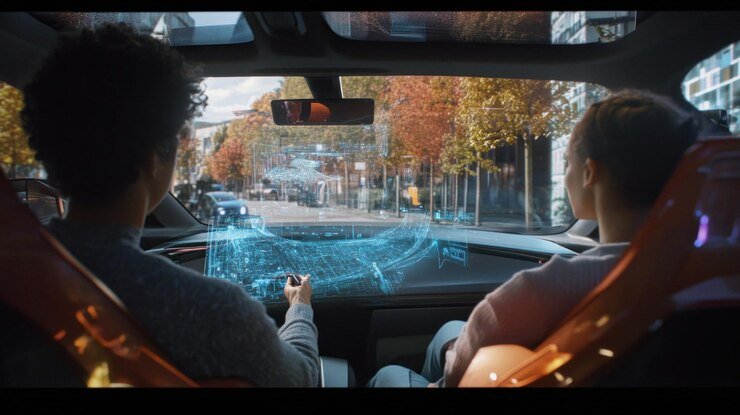The present movement of self-driving cars into the real world is due to advancements in artificial intelligence and autonomous systems. These vehicles will change transportation by making it safer and more effective.
Selfdrivings.com offers information about the growth of self-driving vehicles and their effects. Our team provides specific predictions for the next ten years of self-driving vehicle technology growth in transportation.
The Technological Advancements in Self-Driving Vehicles

AI and Machine Learning Progress
Modern self-driving vehicles use artificial intelligence software and machine learning technology to operate without human drivers. Better vehicle systems will enhance environmental understanding, allowing them to make precise real-time decisions.
Sensor and Mapping Innovations
Self-driving cars depend on LiDAR radar cameras and mapping systems as their main sensing tools. During the next ten years, new sensing systems will enhance navigation accuracy as they generate better-quality data for safe vehicle operation.
Connectivity and V2X Communication
The link between vehicles and all other traffic infrastructure elements, known as Vehicle-to-Everything (V2X) interaction, helps vehicles connect with surrounding facilities. Self-driving vehicle performance depends on this technology since it connects them better to each other and the infrastructure to avoid accidents.
Autonomous Driving Software
The advanced control software inside autonomous vehicles will undergo significant software updates. New driving algorithm enhancements will let self-driving cars manage many road conditions in busy cities and open country areas.
The Legal and Ethical Implications of Self-Driving Vehicles
Regulatory Frameworks
As self-driving cars progress, the government must set quality control standards to keep them safe on the road. The following years will bring complete system changes to control vehicle autonomy.
Insurance and Liability
Our society must address several legal issues regarding driverless vehicle insurance and liability. Whose responsibility falls when a self-driving car causes an accident The modern legal system has to conform to the emerging scenarios connected to self-driving technology.
Ethical Dilemmas
Autonomous vehicles need to handle serious moral choices in moments of danger. How should a car receive instructions and orders in a life-threatening situation? Companies fighting to choose what automatic functions AI systems will perform will produce active dialogues throughout the next ten years of development.
Privacy and Data Security
Self-driving cars collect information about users’ trip preferences and driving routines. Laws need to limit how personal driving data is protected by technology companies.
The Economic and Societal Impact of Self-Driving Vehicles

Job Displacement and Creation
Many transportation and logistics workers could lose their jobs because self-driving cars would become widely accepted as main transportation tools. Introducing new jobs related to AI and robotic maintenance will compensate for the jobs removed from traditional transportation industries.
Cost Efficiency and Consumer Benefits
Thefuture of self-driving vehicles promises significant cost savings in transportation by minimizing the need for human drivers and allowing vehicles to operate more efficiently. As these technologies advance, the public is expected to benefit from lower insurance premiums and reduced time spent on the road. This shift not only cuts travel expenses but also increases overall productivity by freeing up time that would otherwise be spent driving.
Impact on Urban Planning
When vehicles travel more efficiently, they decrease traffic congestion in urban areas and make the environment cleaner. The following ten years will lead to better urban development through reduced parking requirements and improved sustainable transport innovations.
Accessibility and Mobility for All
Self-driving automobiles help disabled people achieve better mobility and enhanced access for seniors and non-drivers. This new technology will help people of all abilities freely use transportation services.
Conclusion
The approaching decade will significantly improve self-driving vehicle technology through technological advancements and create new ways to ride in automobiles. These developments will transform our urban areas and enhance artificial intelligence technology to transform how we travel.
Selfdrivings.com is dedicated to delivering you up-to-date information about Self-Driving Vehicle advances. Through our expert insights, you gain accurate knowledge about key breakthroughs while learning their effects on users and public life.
Visit our Quoraprofile to get more updates and tips.
FAQs
- What are self-driving vehicles?
Self-driving vehicles operate independently through machine learning and sensing systems with artificial intelligence to move from one destination to another. These vehicles provide better safety and better transportation performance.
- How do self-driving vehicles work?
Self-driving vehicles incorporate sensors to read their surroundings and artificial intelligence to take driving actions immediately. The cars depend on a mix of LiDAR, camera, and radar technology to keep them safe on the road.
- What laws must be developed to support self-driving vehicles?
Self-driving vehicles create legal matters between operators and authorities about rules and what happens when accidents happen. Lawmakers need to develop full legal measures to defend public interests.
- How will automated cars transform society’s working structure?
The loss of jobs from driving-specific positions will create new positions in AI technology and vehicle service engineering. People doing work today must learn new ways to perform their duties.
- When will society widely adopt self-driving cars?
The public will see more self-driving cars appear in the following decade because industry advances and official controls are taking shape. They will enter service first in busy city settings, starting with small numbers of cars.

